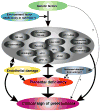The biology of preeclampsia
- PMID: 19657323
- PMCID: PMC4313558
- DOI: 10.1038/ki.2009.284
The biology of preeclampsia
Abstract
Preeclampsia is a systemic disease that results from placental defects and occurs in about 5-8% of pregnancies worldwide. Preeclampsia is a disease of many theories, wherein investigators put forward their favorite mechanistic ideas, each with a causal appeal for the pathogenesis of preeclampsia. In reality, the patho-mechanism of preeclampsia remains largely unknown. Preeclampsia, as diagnosed in patients today, is likely a heterogeneous collection of disease entities that share some common features but also show important differences. Therefore, one single mechanism may never be found to explain all the variants of preeclampsia. Current research must focus on evaluating such diverse mechanisms, as well as the possible common effector pathways. Here, we provide a discussion of several possible mechanisms and putative theories proposed for preeclampsia, with particular emphasis on the recent discovery of a new genetic mouse model offering new opportunities to explore experimental therapies.
Conflict of interest statement
No conflict of interest is reported at the current time.
Figures



References
-
- Martin J, Hamilton B, Sutton P, et al. Births: Final Data for 2006. National Vital Statistics Reports. 2009 - PubMed
-
- Lever JCW. Cases of puerperal convulsions, with remarks. Guy’s Hosp Reports. 1843:495–517.
-
- Rayer P. Traité des Maladies des Reins et des Altérations Sécrétion Urinaire. Vol. 3. Paris: J.B. Baillière; pp. 1839–1841.
-
- Cook H, Briggs J. Clinical observations on blood pressure. Johns Hopkins Hosp Rep. 1903;11:451–455.
-
- Cope I. Plasma and blood volume changes in pregnancies complicated by pre-eclampsia. Journal of Obstetrics and Gynaecology of the British Commonwealth. 1961;68:413–416. - PubMed
Publication types
MeSH terms
Substances
Grants and funding
LinkOut - more resources
Full Text Sources
Other Literature Sources
Medical

